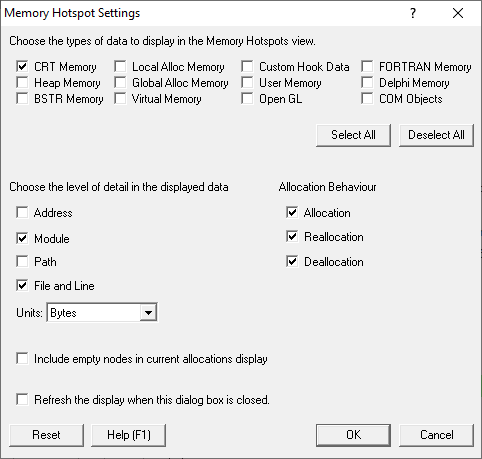The Memory Hotspot Settings dialog controls the type of data that is displayed on the Hotspot tab.

Types of memory to display
The following types of memory allocations can all be optionally displaying in the hotspots view.
•CRT memory
•Win32 heap
•BSTR objects from SysAllocString function
•LocalAlloc()
•GlobalAlloc()
•Virtual memory
•Custom memory allocations using the Custom Hooks functionality
•User memory allocations using the API
•OpenGL
•FORTRAN memory
•Delphi memory
•COM objects
Only CRT Memory allocations are enabled by default.
 Note that these settings control what is displayed, not what is collected. The data collection settings may have more information about some of the settings above.
Note that these settings control what is displayed, not what is collected. The data collection settings may have more information about some of the settings above.
Level of detail displayed
You can choose the level of detail displayed in each entry on the hotspots view:
•Address  displays the address as part of a hotspot entry
displays the address as part of a hotspot entry
•Module  shows the module load address
shows the module load address
•Path  includes the full file path or just the filename when showing file and line below
includes the full file path or just the filename when showing file and line below
•File and Line  shows the filename and line number
shows the filename and line number
•Units  gives allocation sizes in Bytes, KB or MB
gives allocation sizes in Bytes, KB or MB
Allocation behaviour
Memory Validator refers to an allocation as having an allocation behaviour - indicating one of the following:
•Allocation
•Reallocation
•Deallocation
The default is to include all three behaviours in the hotspot calculations
Empty nodes
When the Memory tab option is set to show only live data rather than lifetime data, it is possible for the total number of bytes (or handles) displayed to be zero.
•Include empty nodes...  include zero byte or zero handle entries in the hotspot listing
include zero byte or zero handle entries in the hotspot listing
Refresh and reset
•Refresh the display...  enables updates of the hotspot display whenever this settings dialog is closed
enables updates of the hotspot display whenever this settings dialog is closed
•Reset  revert all these settings to the default values shown in the picture above
revert all these settings to the default values shown in the picture above